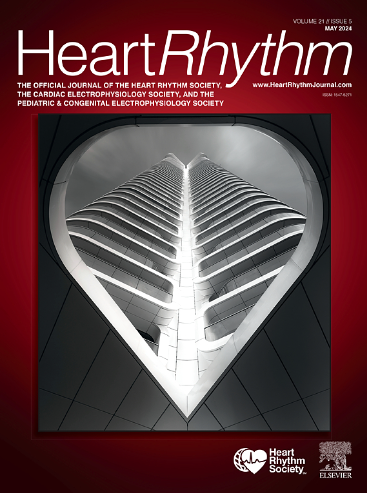Heart transplantation for pediatric patients with malignant arrhythmias: Indications and outcomes
IF 5.7
2区 医学
Q1 CARDIAC & CARDIOVASCULAR SYSTEMS
引用次数: 0
Abstract
Background
Arrhythmias can lead to cardiac arrest and heart failure. When intractable, heart transplantation (HTX) can become the only viable treatment. This rare high-risk cohort has not been reported as a distinct group.
Objective
The purpose of this study was to characterize the outcomes of pediatric patients listed for HTX with the primary indication being malignant arrhythmia (MA).
Methods
Using the Pediatric Heart Transplant Society prospective registry, we identified all patients younger than 18 years listed between 2014 and 2022. MA as the listing indication was categorized into primary tachyarrhythmia (PT), inherited arrhythmia (IA), congenital heart disease, and cardiomyopathy (CM) with secondary arrhythmia. Demographic, listing, and transplant data were analyzed.
Results
Among 4630 patients listed and 3317 transplanted, MA was the indication in 63 (1.4%) and 49 (1.5%), respectively. Patients with MA were categorized as PT in 11 (17%), IA in 4 (6%), congenital heart disease in 6 (10%), and CM in 42 (67%). Compared with the non-MA cohort, patients listed for MA were older (mean age 10.6 ± 6.2 years vs 6.1 ± 6.2 years; P < .01), more likely to present with cardiac arrest (43% vs 11%; P < .01), and less likely to be in the intensive care unit (40% vs 58%; P < .01) or on inotropes (30% vs 60%; P < .01) at the time of listing. Outcomes including waitlist mortality, transplantation, posttransplant survival, and freedom from rejection were comparable to those of the non-MA cohort.
Conclusion
Patients with MA constitute a small proportion of those listed for HTX in childhood. CM was the most common category, while IA and PT were rare. Their waitlist mortality and posttransplant outcomes were comparable to those of the non-MA cohort.

为患有恶性心律失常的儿科患者进行心脏移植:适应症和结果。
背景:心律失常可导致心脏骤停(CA)和心力衰竭。当病情难以控制时,心脏移植(HTX)可能是唯一可行的治疗方法。这一罕见的高危人群尚未作为一个独特的群体进行报道:描述以恶性心律失常(MA)为主要适应症、被列入心脏移植名单的儿科患者的治疗效果:通过小儿心脏移植协会的前瞻性登记,我们确定了所有患者的结果:在4630名列入名单的患者和3317名接受移植的患者中,分别有63人(1.4%)和49人(1.5%)的适应症为恶性心律失常。其中,11 例 MA 患者属于 PT,4 例属于 IA,6 例属于 CHD,42 例属于 CM。与非 MA 患者队列相比,MA 患者的年龄更大(平均(标清)年龄为 10.6 (6.2) 岁 vs. 6.1 (6.2) 岁,p 结论:马氏综合征患者在儿童期因高热惊厥入院的患者中只占一小部分。CM是最常见的类型,而IA和PT则很少见。他们的候诊死亡率和移植后的预后与非MA队列相当。
本文章由计算机程序翻译,如有差异,请以英文原文为准。
求助全文
约1分钟内获得全文
求助全文
来源期刊

Heart rhythm
医学-心血管系统
CiteScore
10.50
自引率
5.50%
发文量
1465
审稿时长
24 days
期刊介绍:
HeartRhythm, the official Journal of the Heart Rhythm Society and the Cardiac Electrophysiology Society, is a unique journal for fundamental discovery and clinical applicability.
HeartRhythm integrates the entire cardiac electrophysiology (EP) community from basic and clinical academic researchers, private practitioners, engineers, allied professionals, industry, and trainees, all of whom are vital and interdependent members of our EP community.
The Heart Rhythm Society is the international leader in science, education, and advocacy for cardiac arrhythmia professionals and patients, and the primary information resource on heart rhythm disorders. Its mission is to improve the care of patients by promoting research, education, and optimal health care policies and standards.
 求助内容:
求助内容: 应助结果提醒方式:
应助结果提醒方式:


